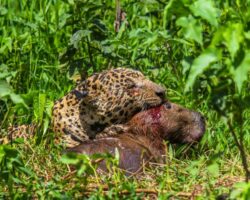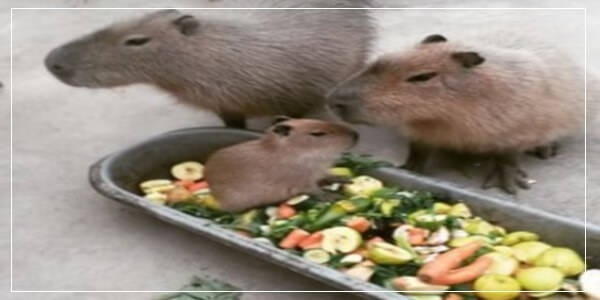Herbivorous are selective in their feeding; capybara (binomially known as Hydrochoerus hydrochaeris) is the world’s biggest living rodent, native to South America.
A grazer in nature, the capybara’s diet is mostly a mix of grasses, aquatic plants, tree barks, and fruits. Due to the fussiness in their food choice in the wet season and their craving for varieties in the dry season, their diet has been brought to question often.
In this post, we’ll be discussing likely fruits that can be fed to Capybaras.
Getting Familiar With Capybaras & Their Fruits
Their scientific name is derived from the Greek root words “hydro”, meaning “water,” and “choerus” which interprets as “pig” or “hog”. Hence, earning them the name ‘water hog’.
Also, the name, Capybara, can be easily translated as “grass eater” and is sometimes thought to mean “master of the grasses”. The capybara is a huge, Cavy semiaquatic mammal of the genus Hydrochoerus, found throughout the whole of South America, except for Chile.
They inhabit densely forested areas near bodies of water, such as; lakes, rivers, swamps, ponds, and marshes. They can also be found in flooded savannahs and along rivers in the tropical rainforest.
They are relatives of rock Cavies and Guinea pigs and are distant relatives to the Agouti, Chinchillas, and Coypu.
Capybara Facts & Description
The Capybara has a heavy, barrel-shaped body similar to a pig’s and blunt muzzles, nostrils, eyes, and ears located high on top of their small head like a hippopotamus.
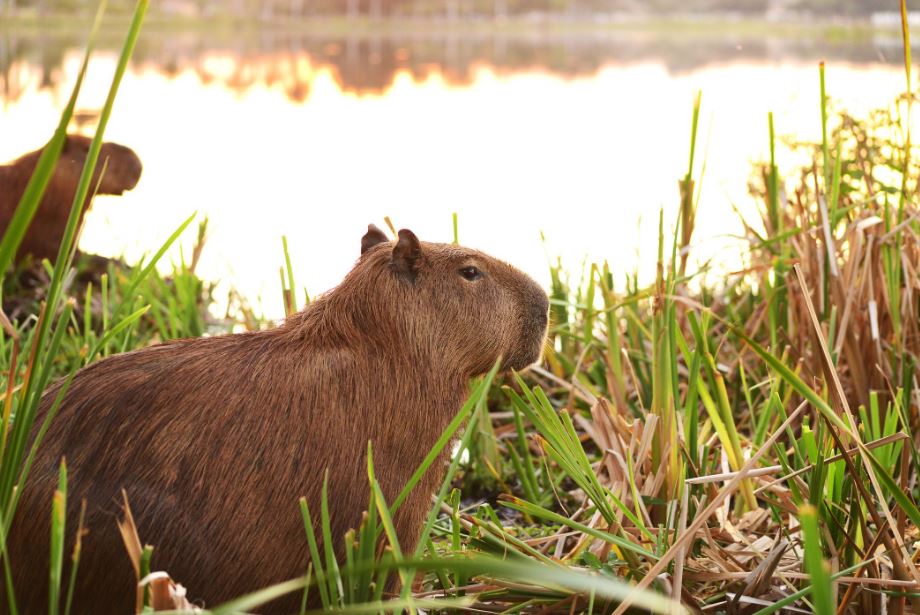
These unusual features give them enhanced sight, hearing, and sense of smell when underwater and are useful in keeping them hidden from supposed predators.
They have a brittle, long reddish-brown fur on the upper part of their bodies, perfect for drying out their fur while on land; a vestigial tail, and partially webbed toes, used in paddling around in bodies of water.
Their hind legs are slightly longer than their forelegs, and they have hoof-like claws on their toes (they have three toes on their rear feet and four toes on their front feet).
They are amphibious animals, a characteristic feature that aids their land adaptation and superb diving and swimming skills in the water.
Capybara Anatomy & Physiology
Like rabbits, Capybara has a digestive system consisting of a single stomach, a large intestinal pouch (caecum), and microorganisms that aid the fermentation of high cellulose contained in the grass plants they consume.
Moreover, capybaras re-ingest their colorless, protein and vitamin-rich feces, which help to break down the cellulose in the grass, along with aiding their digestive system in general (coprophagy).
Their excreta comes in variants of olive-green colored oval balls and in a softer sausage shape. The former indicates healthy feeding, while the latter is a sign of wrong diet or feeding.
As with other rodents, the front teeth of capybaras grow continually to compensate for the constant tear and wear from eating grass, and their cheek teeth also grow continuously.
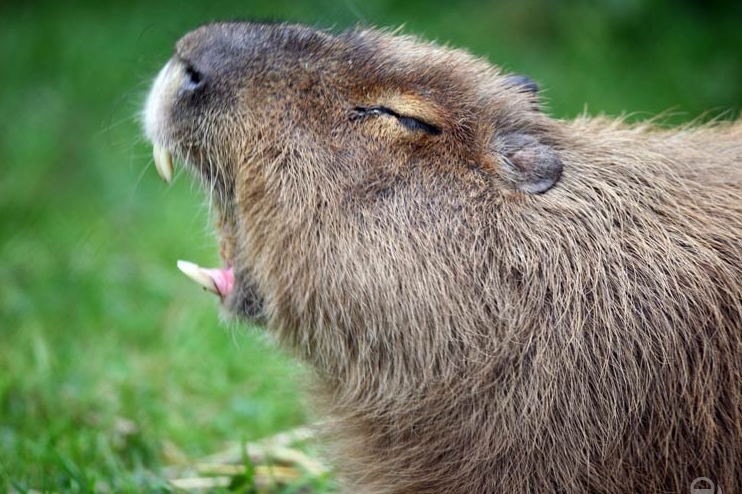
And unlike most rodents, they can regurgitate their food for further masticating while sleeping, as seen in cud-chewing cattle, and as well grind or chew their food in the back-and-forth manner of a camel rather than the side-to-side chewing accustomed to humans.
Capybara Feeding & Diets
As stated earlier, capybaras are selective in their food choice, eating vegetation high in protein and energy instead of diets low in protein and energy typically known to most grazers.
The wild diet of a capybara varies from season to season. While in the dry season (where food availability and quality are reduced), capybaras tend to eat reeds, grains, melons, and squashes.
However, in the wet season (where there are abundant resources), 80% of their diet is only five species of grasses (Poaceae) and can include herbaceous plants, leaves, aquatic plants (reeds, water hyacinths), grasses, and crops (fruits, grains, seeds, vegetables).
However, due to their inability to synthesize essential Vitamin-C by themselves, also common with their closest relative, the guinea pig, when not supplemented with Vitamin-C, Capybaras in captivity (such as those kept as pets) are reported to develop gum disease as a sign of scurvy.
To fill this void and restore their health, most owners feed their pets fruits and vegetables rich in Vitamin-C, such as carrots and apples.
Capybaras And Their Fruit Consumption
While it’s good to feed your pet capybara with a mix of vegetables and fruits, it’s better to be aware that our cultivated fruits are high in sugars that easily disrupt their gut microbial population.
Since rodents are addicted to sugar and sweet food, fruit, and vegetable consumption should comprise less than 5% of the capybara diet. Even when they are to be introduced, the fruit and vegetable varieties used should be low in sugars, and vegetables should be emphasized over fruit.
Limiting fruits and vegetables will also encourage the ingestion of appropriate foods such as pellets and forage (branches, hay) and will decrease dietary starch and sugars that can cause GIT inflammation, extreme fluctuations of GIT pH, and Type II diabetes.
It should be known that the capybara digestive system evolved over 30 million years to take advantage of a diet high in fiber and low in nutritional content. Unlike humans, whose digestive systems tolerate unnatural feed, the capybara digestive system is sensitive.
To stay in line with the dietary information and ensure healthy living for pet capybaras, we’ve made a list of selected fruits to feed your capybara with.
1. ORANGE
Orange is an excellent source of Vitamin C needed by pet capybaras to prevent teeth and gum disease and other related diseases related to scurvy.
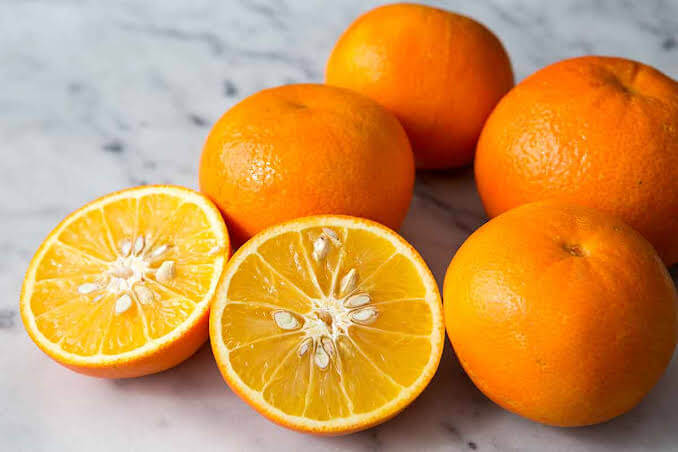
Also, orange has higher energy and slightly lower protein and dietary fiber levels than capybaras prefer. Capybaras can eat both the fleshy part and the rind of an orange. Apart from the consumption of oranges, many people include oranges in their capybara baths.
2. PEARS
Pears like oranges have a higher level of energy, a slight percentage of dietary fiber, and a low level of protein.
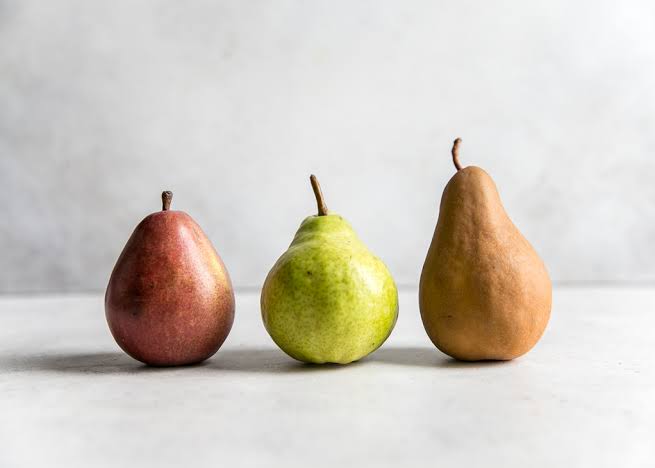
Due to their nutritional value, pears can be introduced to pet capybaras.
RECOMMENDED:
3. GRAPES
Grapes are rich in vitamins and other nutrients but low in dietary fiber and proteins. Also, grapes have higher sugar levels when compared to oranges and pears.
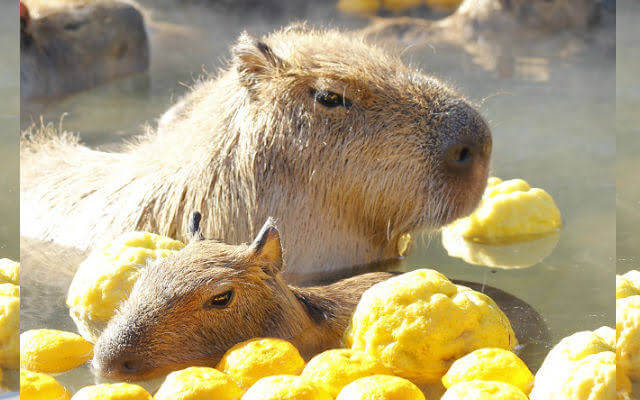
Consequently, grapes should be given occasionally to capybaras to not cause a gut upset.
4. APPLES
Apples are enriched with Vitamin-C and other Vitamins and lots of water.
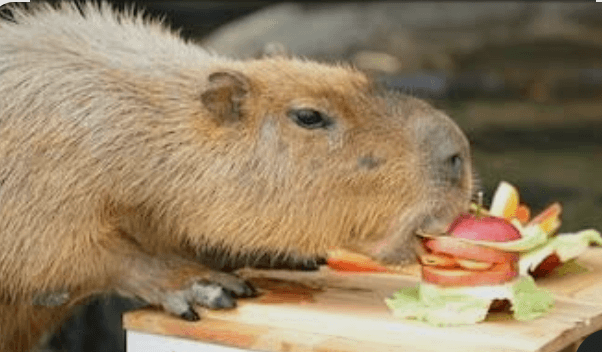
They are also a good source of energy and have moderate dietary fiber and a lesser content of protein. A moderate diet of apples is good for a pet capybara.
5. BANANA
Bananas are a good source of energy and water. And due to their moderate protein and dietary fiber content, they are a good fruit choice for pet capybaras.
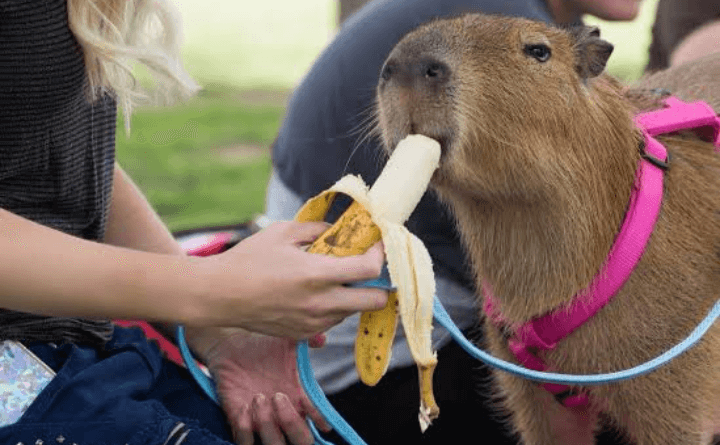
Nonetheless, a pet capybara should be fed with bananas in a metered routine, as bananas also have a high sugar level.
6. WATERMELON
Watermelons have a higher proportion of water and a slightly lower level of energy, protein, and dietary fiber than fruits.
Due to the abundance of water in melons and their refreshing taste, a capybara may be served a treat of melon once or twice a week to supplement its water. Both the flesh and rinds of watermelon are healthy for capybaras.

And given their ever-growing front teeth, regurgitating capabilities, and ability to chew back and forth, it’s easier to get the melon and its rind into their digestive system.
The risk of feeding a pet capybara melon is the high presence of sugar, which can cause digestive upset and diarrhea. And not of the seed, which can be easily regurgitated and grounded by their teeth.
7. TOMATOES
Tomatoes are fruits rich in Vitamin A, B6, and C. They are juicy and can be a good source of water for capybaras. As with all fruits, tomatoes should only be a treat offered once or twice a week to your pet capybara.
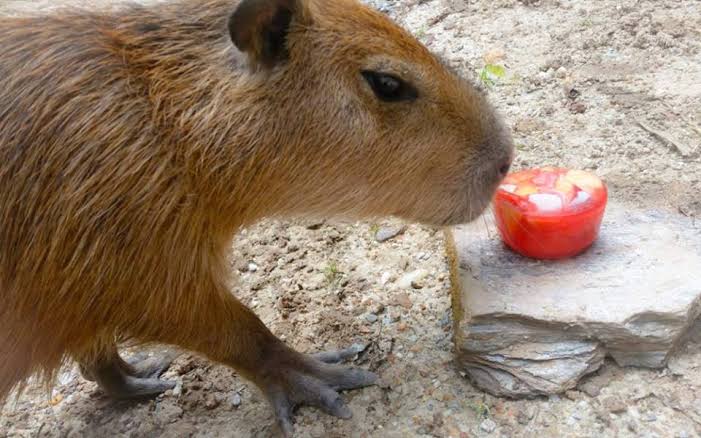
However, a high concentration of sugar and acidity in tomatoes is a major risk to capybaras in that they increase the growth of harmful bacteria in their guts, leading to painful bloating.
8. MANGOES
Mangoes have a significant amount of energy and Vitamin-C value, which is needed by capybaras since they can’t synthesize this on their own.
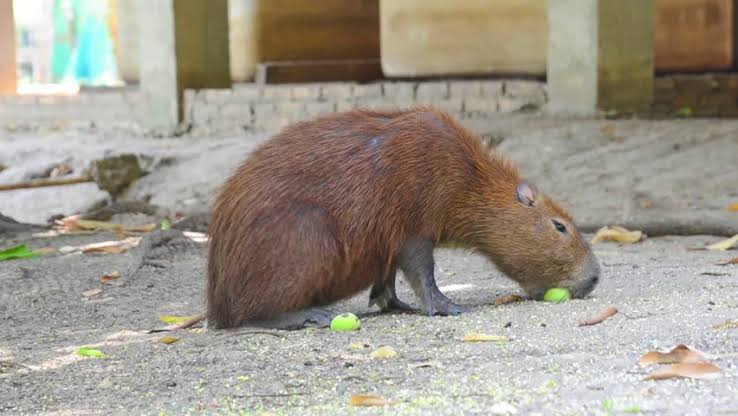
Although nutritious, capybaras should be fed mangoes less as it has a high proportion of sugar in them. When served to pet capybaras, they should be sliced, and their stones should be removed to avoid the risk of swallowing.
9. PEACH
Peaches are juicy and have a significant content of water, energy, and a mere value of proteins.
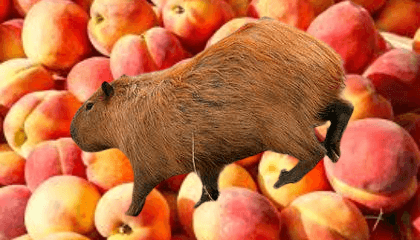
A little attention is needed when feeding pet capybara peaches as they have a single stone in them and, when swallowed, may affect the capybara.
10. PLUM
Plums have a reduced sugar rate compared to most juicy fruits, and it’s highly enriched with Vitamin-C.
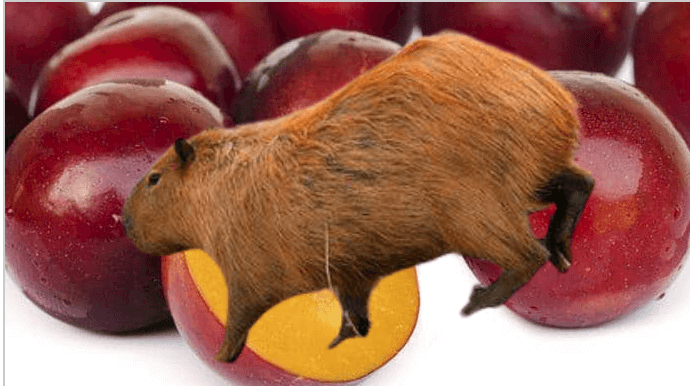
It’s a good source of energy and dietary fiber. Both dried and fresh plums may be introduced as a treat to pet capybaras’ diet.
11. KIWI FRUIT
Kiwis are of the berry family packed with Vitamin-C and other vitamins that can prove essential for capybaras.

They also have notable values of energy, dietary fiber, and protein. And can be offered as a treat to pet capybara on occasion.
12. CANTALOUPE
Cantaloupe is a melon and a variety of muskmelon species, with a relatively low protein and dietary fiber content. Like other species of its family, cantaloupe has more water and nutrients.
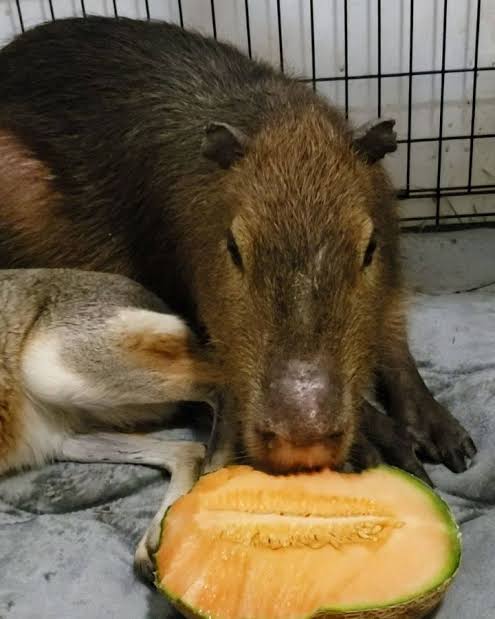
Its seed can be consumed by capybaras, who can easily grind it with their teeth and regurgitate it for further chewing. Nevertheless, cantaloupe’s skin should be scrubbed and washed clean before giving it to a pet capybara to avoid harmful bacteria retained on its surface.
13. CUCURBITA
Unlike most species in the gourd family, Cucurbita/Squash has a lower sugar content value and a low energy level when compared to other genera of their species.
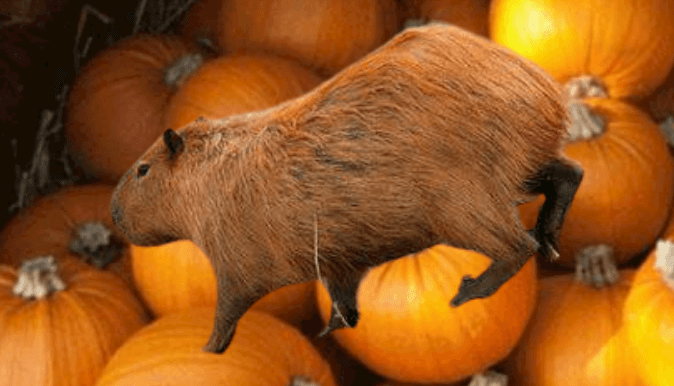
They can be used as varieties when giving a pet capybara an occasional treat.
14. PUMPKIN
A member of the squash family, pumpkins have a great energy value. It serves as an excellent source of water and has a moderate value for proteins and Vitamin-C.
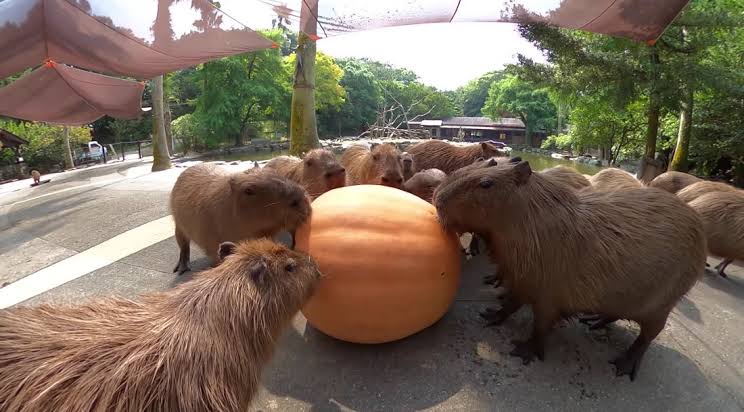
Most parts of a pumpkin can be eaten by a pet capybara, including the fleshy shell and the seeds. Like all fruits, less diet of pumpkin is more.
15. STRAWBERRY
Strawberry is a juicy fruit with a refreshing and sweet flavor.

It’s an excellent source of Vitamin C, energy, and moderate dietary fiber. Strawberries may also be offered in small amounts in capybaras’ diet.
16. CUCUMBER
Belonging to the gourd family, cucumber-like other members of its genus, has ninety-five percent water value, a mere notable sugar, protein, and dietary fiber level.
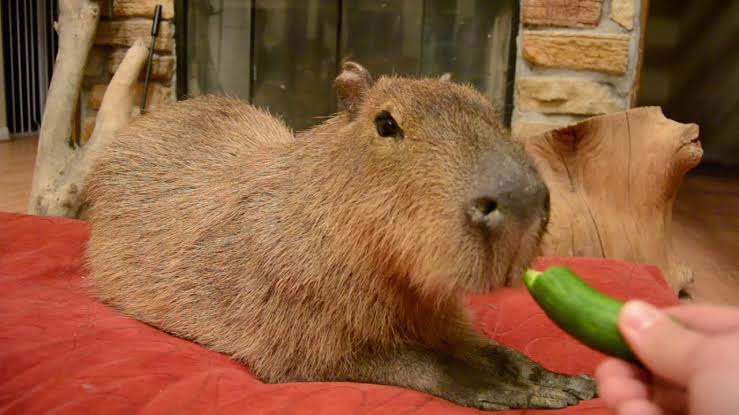
Also, it can be eaten whole by capybaras.
17. RASPBERRY
Raspberries have a higher proportion of dietary fiber and negligible protein.
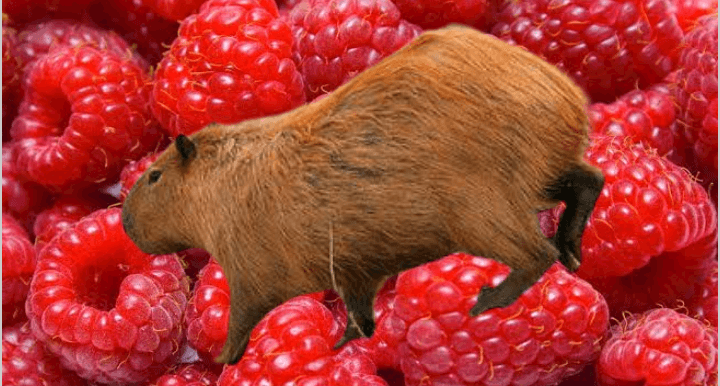
They constitute eighty-six percent of water and are a good source of energy. Their rough-appearing surface and seed can both be eaten by capybaras.
18. REDCURRANT
Redcurrant is a member of the genus Ribes in the gooseberry family. And has a higher sugar level, moderate dietary fiber, and protein value.
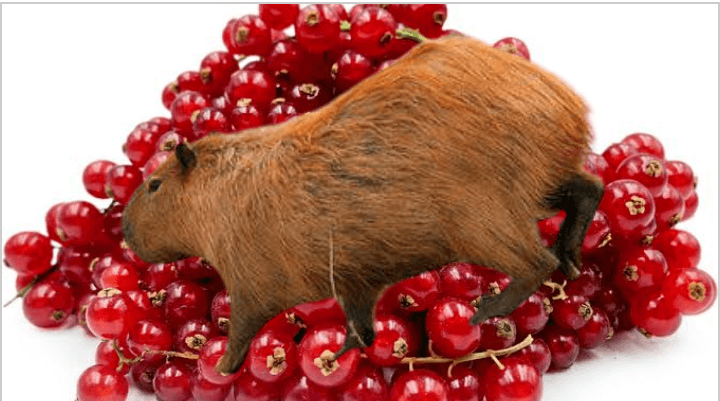
They are also a good energy source and a rich source of vitamin C. They can be adopted into the capybara’s fruit diet.
19. CHERRY
Cherries belong to the genus Prunus and constitute a moderate Vitamin C and dietary fiber content. They are a good source of energy and water. And has a high content of sugar in them.
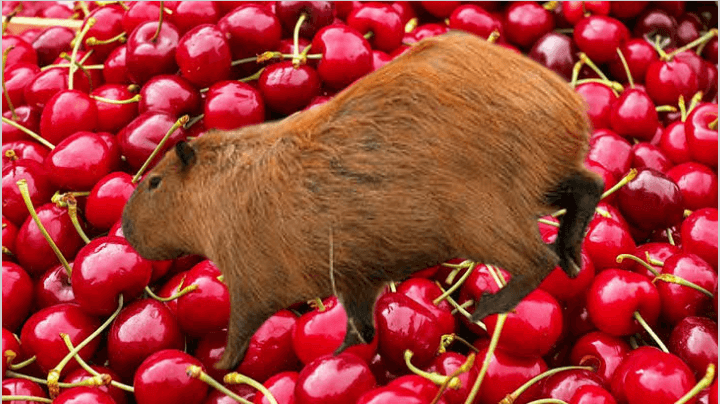
Being a drupe, they are a stone fruit, and the stone must be removed before being fed to a pet capybara.
20. PAPAYA
Papaya has a negligible protein content and a moderate amount of dietary fiber. And is a significant source of water, Vitamin C, and energy.
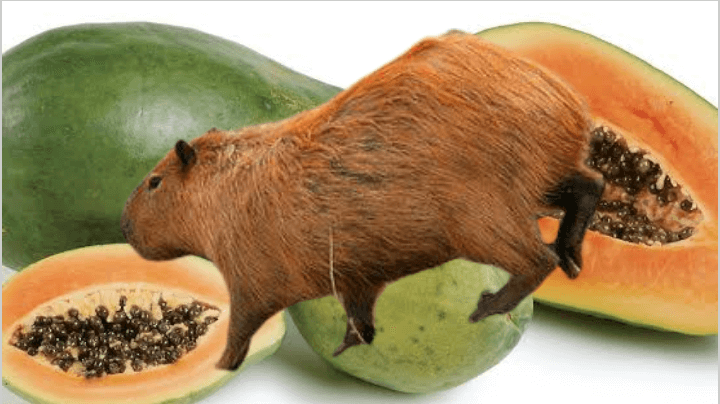
Capybara can eat papaya skin, pulp, and seed. But it should be given only as a treat due to its higher concentration of sugar level.
Conclusion
If you have a pet capybara, you can consider feeding it with any of the above fruits. You may be wondering why lemons aren’t mentioned. While capybaras may consume lemon, they do not like it. However, they enjoy bathing with lemons, which can improve their skin health.
Not all plants are safe for capybaras to consume. Take note of poisonous plants such as Jimson Weed, Foxglove, and Western Water Hemlock, which can harm your capybara. Should your capybara ingest any of these dangerous plants, it may suffer from acute kidney failure, respiratory distress, diarrhea, vomiting, and even death.

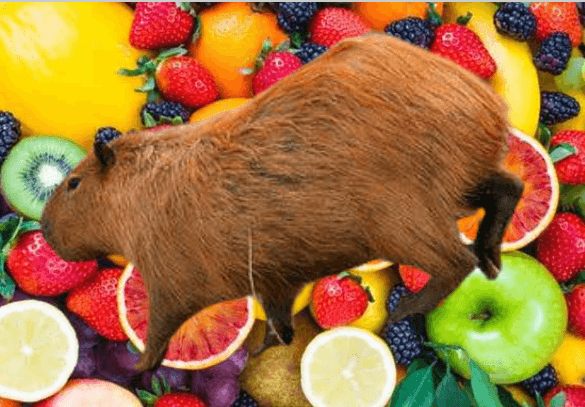
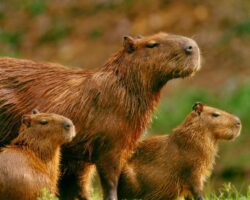
![Why Do Capybaras Not Have Tails? - [Answered] Why Do Capybaras Not Have Tails](https://capybaratips.com/wp-content/uploads/2023/03/Capy-Tail-250x200.webp)
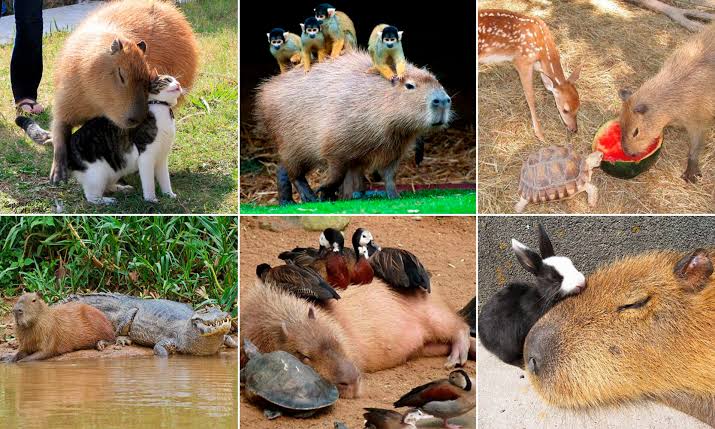
![How Long Do Capybaras Live? - [Answered] How Long Do Capybaras Live](https://capybaratips.com/wp-content/uploads/2023/03/Capybara-Pix-250x200.webp)

